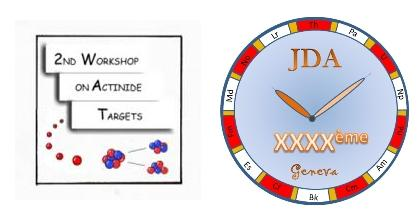Speaker
octavian valu
Description
High temperature drop calorimetry for actinide samples
Octavian S. Vălu1,2, Markus Beilmann2, Ondrej Beneš2 and R. J. M. Konings2
1 ”Al. I. Cuza” University, Department of Chemistry, 11 – Carol I Blvd., 700506 – Iaşi, Romania,
e-mail: octavian.valu@yahoo.com
2 European Commission, Joint Research Centre, Institute for Transuranium Elements, Karlsruhe, Germany
Using a Setaram multi-detector high temperature calorimeter (MHTC 96 type) operating in drop mode we try to prove that it is possible to perform drop calorimetric measurements for actinide samples using a very small amount of substance (less than 150 mg).
Therefore, we performed drop calorimetric measurements for CsF samples and compare our results with existing literature data Nist – Janaf [1] and A. C. Macleod [2].
a) b)
Fig. 1. Results of our experiment and Macleod’s work. a) liquid phase; b) solid phase
Using the equations from Figure 1, which are obtained from linear fit of the data, the enthalpy of fusion is calculated as well as the heat capacity for our experiment and Macleod’s work. The results of the calculation are shown in Table 1.
Table 1. Enthalpy of fusion and heat capacity of CsF.
Comparing our results with the results of Macleod we can observe that the heat capacity has a very similar value. It is important to mention that in his experiment Macleod used an amount of 10 g of CsF for every drop whereas we used only 150 mg. From here we conclude that it is possible to analyze actinide samples using a relatively small amount of substance obtaining enough accurate results in order to predict the behavior of the Molten Salt Reactor (MSR) fuel.
The principle of the Drop technique is based on measuring the enthalpy increments of a sample, while dropping it from ambient temperature (exactly measured) to the programmed temperature, which is kept at constant value. The crucible design used for the encapsulation was presented in Beneš et al. [3].
Each measurement consists of several drops made in 25 minutes intervals, enough to re-stabilize the temperature and the heat flow signal. From several measurements the temperature function of enthalpy is obtained and from these results the heat capacity is derived according to equation: CP = .
Prior to each drop the samples were stored in a sample holder, which is positioned over the detector. The furnace of the calorimeter is programmed to stabilize at desired temperature and to keep it constant during the experiment. After this period the sample is dropped into the calorimeter. At this moment extra heat (monitored as heat flow) is delivered into the detector in order to maintain the pre-set temperature. The amount of heat corresponds to the energy which is necessary to heat up the sample from ambient temperature to the operation temperature. Typical results of one measurement are shown in Figure 2. Before and after every sample, a reference material is dropped to determine the sensitivity of the detector. As reference material we used small pieces (75 – 95 mg) of corundum (Al2O3) whose heat capacity is known.
Fig. 2. An example of measurement made by Drop calorimeter; the investigated sample is CsF and as reference we used Al2O3.
Each peak, on the heat flow curve, is analyzed individually by integration with respect to time, using OriginPro 7.5 Software and knowing the sensitivity of the calorimeter the obtained are is converted into enthalpy.
The same technique to measure the high temperature heat capacity has been used by Burriel et al. [1] and Beneš [3].
References
[1] NIST – JANAF, Thermochemical Tables, Fourth Edition, Part II, Journal of Physical and Chemical Reference Data.
[2] A. C. Macleod, High-temperature Thermodynamic properties of the Alkali-metal Fluorides, J. Chem. Soc. Faraday Trans I, 2026-2035, (1973).
[3] O. Beneš, R. J. M. Konings, C. Kuentzel, M. Sierig, A. Dockendorf, L. Vlahovic, J. Chem. Thermodyn., 41, 899 – 903, (2009).
[4] P. D. Desai, Int. J. Therm., 8, 763 – 780, (1987).
[5] Octavian S. Vălu, Markus Beilmann, O. Beneš, R. J. M. Konings, The high temperature heat capacity of CsF, in publication.




